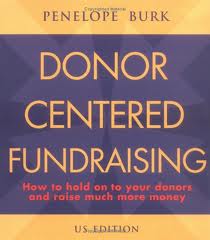 A few months ago, I had a horrible experience with my favorite airline. Long story short . . . delay, delay, delay, delay, loaded on the plane, equipment malfunction, delay, delay and finally up-up-and-away. A whole day was lost. However, in that catastrophe, I was able to learn something about Twitter and the new age of customer service. In the last few weeks, I’ve been reminded of this experience when two bloggers talked about Twitter. So, I thought I’d we’d look Twitter a little more closely today, especially as it relates to non-profit organizations.
A few months ago, I had a horrible experience with my favorite airline. Long story short . . . delay, delay, delay, delay, loaded on the plane, equipment malfunction, delay, delay and finally up-up-and-away. A whole day was lost. However, in that catastrophe, I was able to learn something about Twitter and the new age of customer service. In the last few weeks, I’ve been reminded of this experience when two bloggers talked about Twitter. So, I thought I’d we’d look Twitter a little more closely today, especially as it relates to non-profit organizations.
Tweet: Customer service
As I sat on that airplane for hours with cranky passengers and screaming babies, I remembered something I had read in The Social Media Bible about a similar experience that the author — Lon Safko — had on a Continental Airlines flight. In his example (found on page 8), his assistant used her smartphone and tweeted about her experience making sure to copy the airline on her tweet. No sooner had she taken her seat and a flight attendant was bringing her a glass of champagne with an apology.
With this story in mind, I whipped out my cell phone and started tweeting my displeasure.
Sure enough, the airline’s customer service representatives were paying attention and asked me about the situation. They checked into other flights. They tried to help, and when they couldn’t do anything, they apologized and compensated me with some rewards points.
The point of this story? Twitter is a TWO-WAY communication channel that for-profit companies are learning to master.
I recently read a blog post from Rachel Sprung at Social Media Examiner titled “4 Examples of Excellent Twitter Customer Service“. If you have some time this morning, I encourage you to click-through and read Rachel’s post. She shared additional good stories about Jet Blue, Nike, Seamless, and Comcast. It is worth the click!
Tweet: Donor communication
 I am on Twitter every day. I’m not there very long. I’m not a Twitter expert. I’m sure that I am doing lots and lots wrong in the eyes of social media experts. However, I do see lots of content and most of those who I’m following are non-profit organizations.
I am on Twitter every day. I’m not there very long. I’m not a Twitter expert. I’m sure that I am doing lots and lots wrong in the eyes of social media experts. However, I do see lots of content and most of those who I’m following are non-profit organizations.
I can honestly say that I’ve never seen a non-profit organization with a Twitter account engage in a discussion with a donor, client, or almost anyone. I’m sure it happens, but I’ve never seen it and I’m following 1,808 people/agencies.
I recently read a blog post from Steven Shattuck, who is the VP of Marketing at Bloomerang. The post was titled “11 Mistakes Nonprofits Make On Twitter And How To Avoid Them“. And oh yeah . . . does he hit the nail on the head! Here are just a few of the mistakes he points out:
- Broadcasting instead of engaging
- Talking too much about yourself
- Neglecting hashtags
- Not tracking results
I won’t share all 11 mistakes, and I also won’t tell you how to avoid those mistakes. Why? Because you need to click-through and read Steven’s post. As with the previous post by Rachel which I mentioned in the previous section, Steven’s post is also definitely worth the click!
Tweet: How should your agency use Twitter?
 This is a tough question to answer because I suspect it may vary slightly from agency-to-agency. However, some of the better non-profit organizations are tweeting the following:
This is a tough question to answer because I suspect it may vary slightly from agency-to-agency. However, some of the better non-profit organizations are tweeting the following:
- picture of the day (demonstrating impact of their programming)
- sharing stories about clients, donors, volunteers and board members
- thanking followers for sharing content (e.g. “thanks for the RT” or “thanks for the MT”)
Back in the stone age before there was Twitter, I knew non-profit professionals who would dutifully read the newspaper every morning. When they saw an article or something about a volunteer, donor or board member, they would clip the article and send it to the person with a kind note.
What is stopping your agency from clicking through a few of your Twitter followers profiles and re-tweeting or mentioning something about their content/tweet? After all, it is akin to clipping something out of the newspaper, right? And it sends the message — loud and clear — that you care enough about them to read what they are tweeting. Just a thought!
If you want to read more about what other agencies are doing with Twitter, here are a few good online articles that I’ve found:
- Sprout Insights blog: “5 Nonprofits Using Twitter Right“
- Twitter.com: “Twitter for organizations & nonprofits“
- SlideShare presentation from Blackbaud: “Twitter For Nonprofits“
How is your agency using Twitter? What is working? What isn’t working? How are you using Twitter to engage board volunteers? Donors? Clients? Volunteers? Please use the comment box below and share your experiences. We can all learn from each other.
Here’s to your health!
Erik Anderson
Founder & President, The Healthy Non-Profit LLC
www.thehealthynonprofit.com
erik@thehealthynonprofit.com
http://twitter.com/#!/eanderson847
http://www.facebook.com/eanderson847
http://www.linkedin.com/in/erikanderson847

 Sometimes I see things at just the right time and in the right place, and it results in me seeing something differently. Usually, when this happens it results in an AH-HA moment. This is exactly what happened to me yesterday when I opened an email from my friends at
Sometimes I see things at just the right time and in the right place, and it results in me seeing something differently. Usually, when this happens it results in an AH-HA moment. This is exactly what happened to me yesterday when I opened an email from my friends at  So, the title of today’s blog post had the word “AH-HA” in it, which implies that my friends at Non-Profit Humour inspired a light bulb of some sort.
So, the title of today’s blog post had the word “AH-HA” in it, which implies that my friends at Non-Profit Humour inspired a light bulb of some sort. Yes, yes, yes . . . I know what you’re thinking: “Our agency doesn’t have things like hotel rooms, flights and cups of coffee to give away like these for-profit corporations.” But are you sure about that? Because I’ve attended many charity auctions in my life.
Yes, yes, yes . . . I know what you’re thinking: “Our agency doesn’t have things like hotel rooms, flights and cups of coffee to give away like these for-profit corporations.” But are you sure about that? Because I’ve attended many charity auctions in my life. Last week I was out with a friend for a glass of wine after work. We hadn’t seen each other in a few months, and we were catching up on lost time. “How are you? How is the new job? How’s your wife? Kids? Grandkids?” You know the drill. It was during this exchange that he dropped the bomb: “So, how is your partner? Ya know … the only time I ever see him is when he is asking me for a donation.”
Last week I was out with a friend for a glass of wine after work. We hadn’t seen each other in a few months, and we were catching up on lost time. “How are you? How is the new job? How’s your wife? Kids? Grandkids?” You know the drill. It was during this exchange that he dropped the bomb: “So, how is your partner? Ya know … the only time I ever see him is when he is asking me for a donation.”
 These personal touches do not have to be all about your non-profit organization. I suggest that you train your volunteers to be less obvious. For example, both stewardship touches could be as simple as three minutes worth of messaging in the middle of a lunch meeting or after-work cocktail. It should feel organic and nature. It shouldn’t feel forced or contrived.
These personal touches do not have to be all about your non-profit organization. I suggest that you train your volunteers to be less obvious. For example, both stewardship touches could be as simple as three minutes worth of messaging in the middle of a lunch meeting or after-work cocktail. It should feel organic and nature. It shouldn’t feel forced or contrived. Welcome to O.D. Fridays at DonorDreams blog. Every Friday for the foreseeable future we will be looking at posts from John Greco’s blog called “
Welcome to O.D. Fridays at DonorDreams blog. Every Friday for the foreseeable future we will be looking at posts from John Greco’s blog called “ If I’ve seen it once, I’ve seen it hundreds of times. And I bet you have, too. I will omit the names to protect the innocent.
If I’ve seen it once, I’ve seen it hundreds of times. And I bet you have, too. I will omit the names to protect the innocent. We’ve also all seen this situation.
We’ve also all seen this situation. A non-profit organization that doesn’t invest time and resources into evaluation and critique is akin to an ostrich sticking its head in the sand.
A non-profit organization that doesn’t invest time and resources into evaluation and critique is akin to an ostrich sticking its head in the sand. Over the years, I’ve met non-profit board volunteers who didn’t see value or the need for staff. Likewise, I’ve met countless numbers of staff who complain about their board members. I’ve also met executive directors who deliberately do things to disengage their board volunteers (e.g. taking on fundraising responsibilities, reducing the number of board meetings, etc).
Over the years, I’ve met non-profit board volunteers who didn’t see value or the need for staff. Likewise, I’ve met countless numbers of staff who complain about their board members. I’ve also met executive directors who deliberately do things to disengage their board volunteers (e.g. taking on fundraising responsibilities, reducing the number of board meetings, etc). Welcome to part four of our five part series on Governance. We have already discussed the Board’s role in
Welcome to part four of our five part series on Governance. We have already discussed the Board’s role in 



 Welcome to O.D. Fridays at DonorDreams blog. Every Friday for the foreseeable future we will be looking at posts from John Greco’s blog called “
Welcome to O.D. Fridays at DonorDreams blog. Every Friday for the foreseeable future we will be looking at posts from John Greco’s blog called “ I find this distinction really fascinating, and I haven’t been able to stop thinking about it since I read this post. So, I’ve been focused on identifying some non-profit related “predicaments” and here is what I’ve come up with . . .
I find this distinction really fascinating, and I haven’t been able to stop thinking about it since I read this post. So, I’ve been focused on identifying some non-profit related “predicaments” and here is what I’ve come up with . . . Board member engagement is a common thread running through many of my blog posts. This isn’t because I’m a broken record. The fact of the matter is that so many of the things that plague non-profits are simply “symptoms” of a bigger problem. Yep, you guessed it . . . the root cause of many of our challenges in the can be traced back to our boards.
Board member engagement is a common thread running through many of my blog posts. This isn’t because I’m a broken record. The fact of the matter is that so many of the things that plague non-profits are simply “symptoms” of a bigger problem. Yep, you guessed it . . . the root cause of many of our challenges in the can be traced back to our boards.